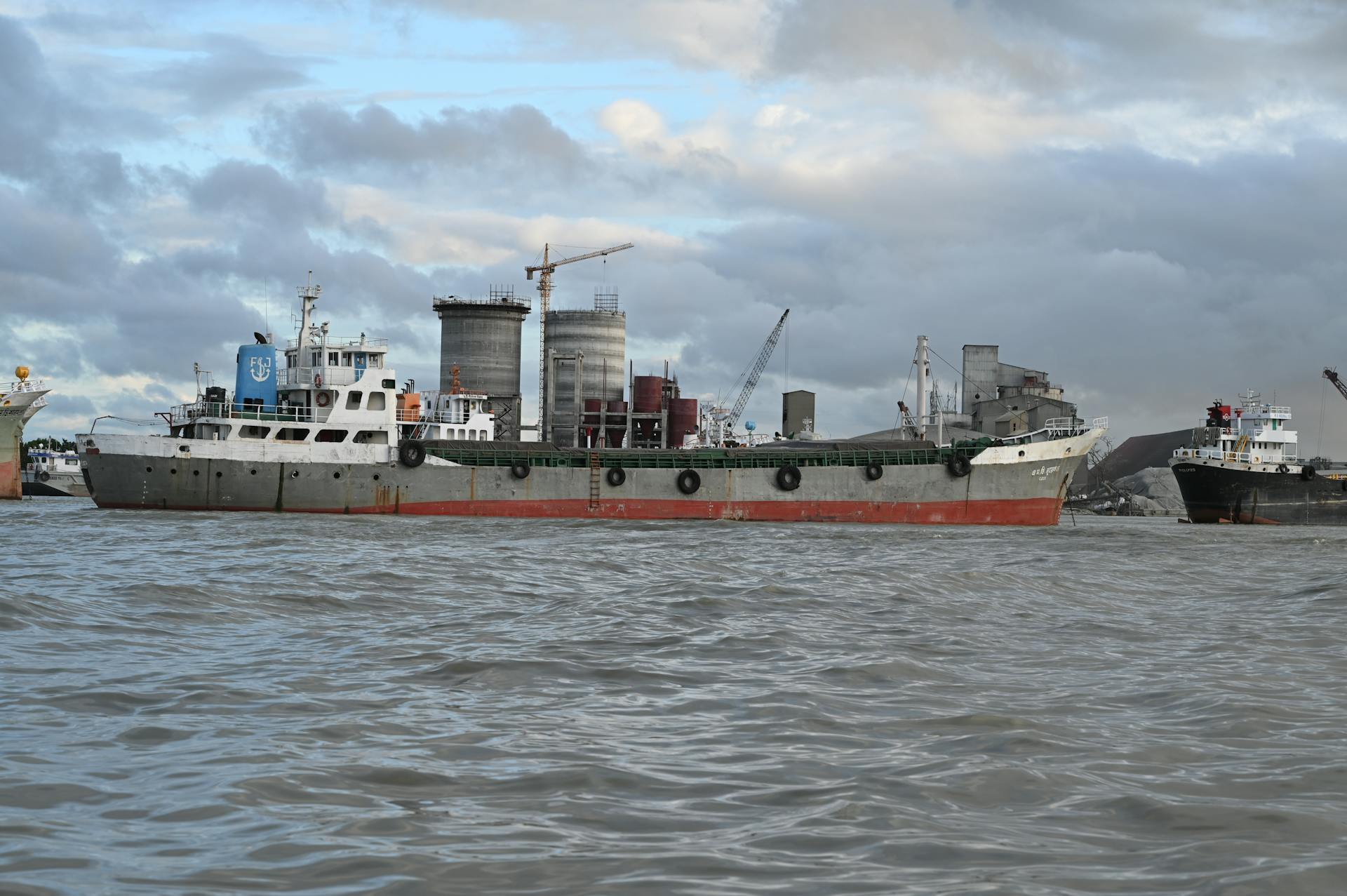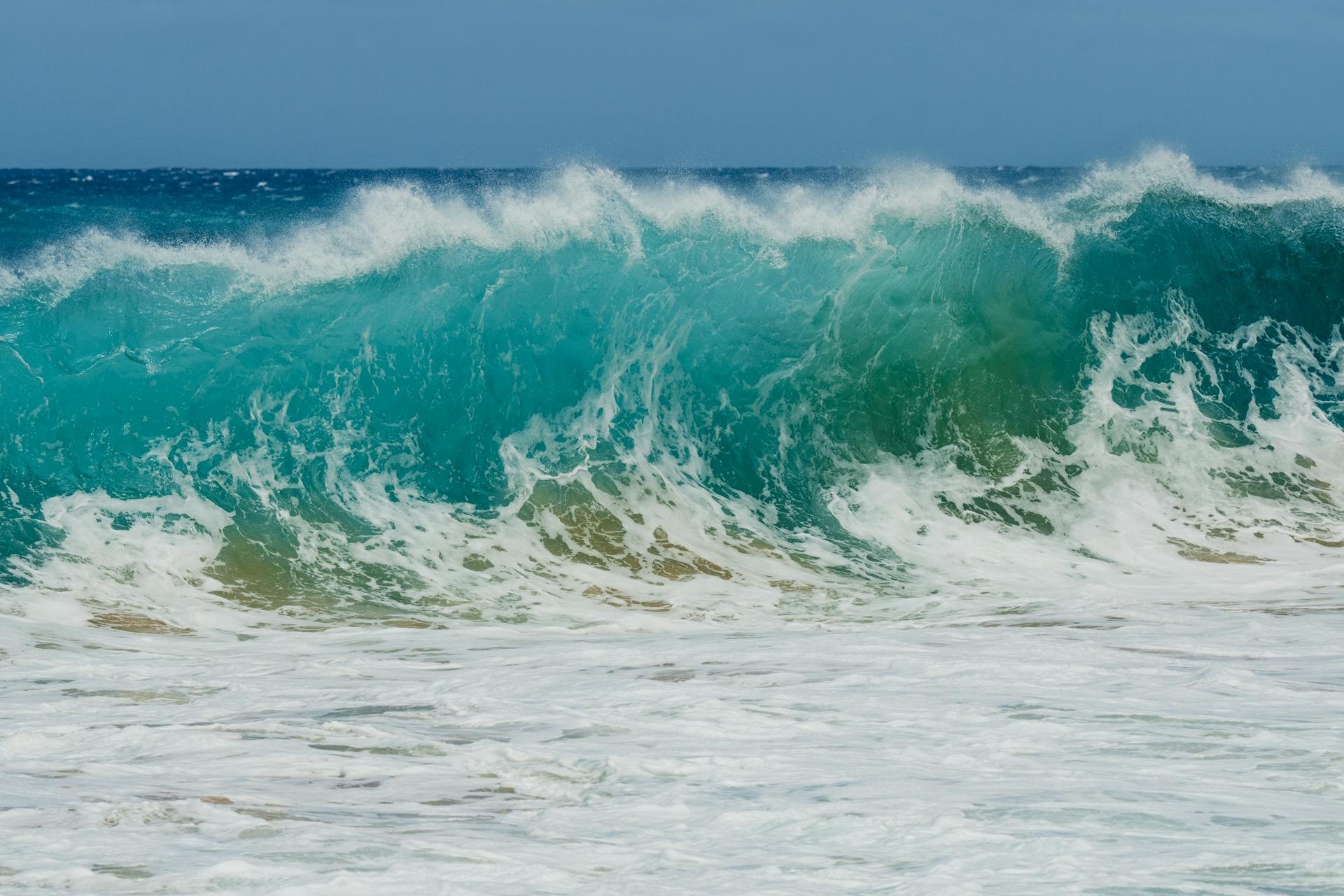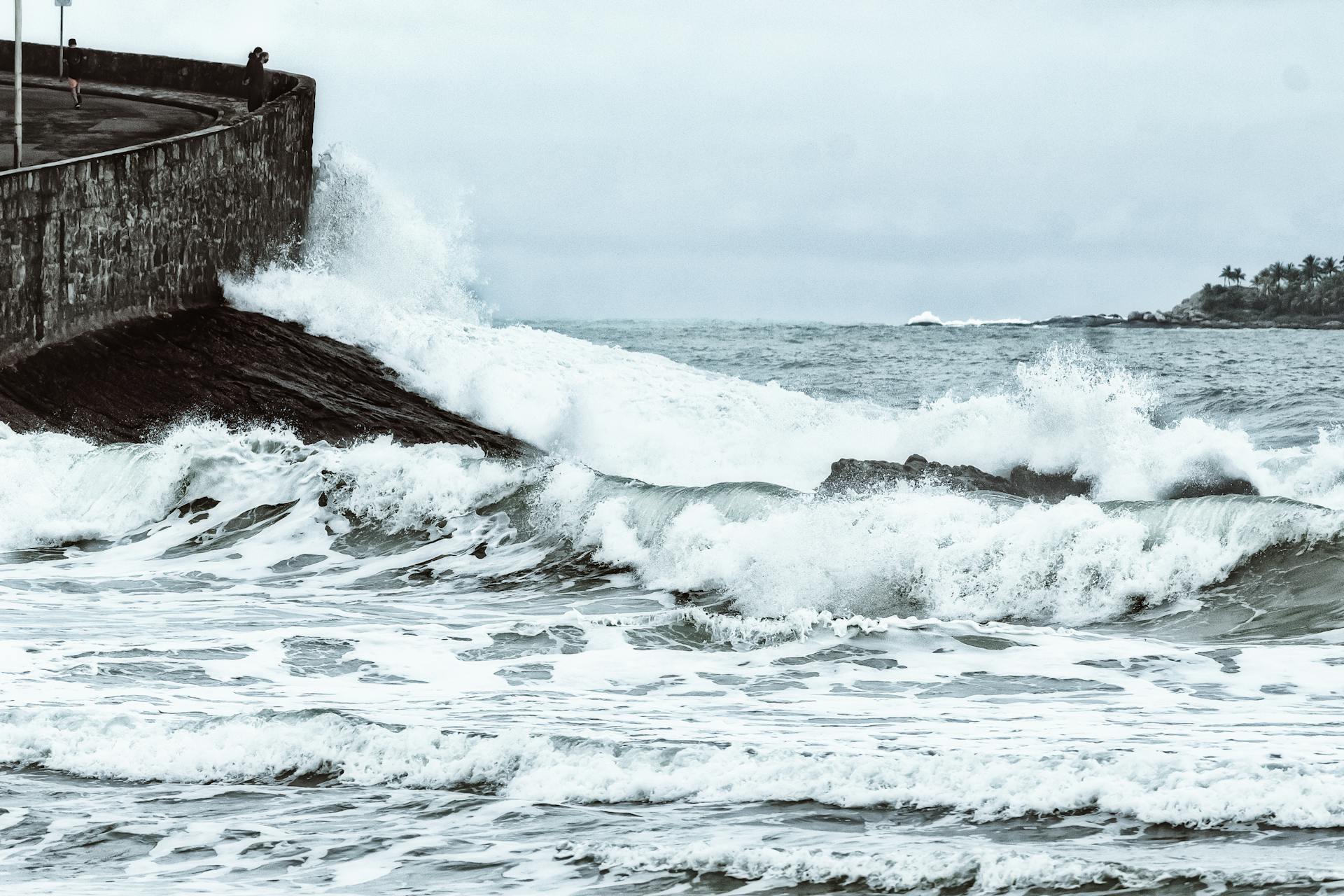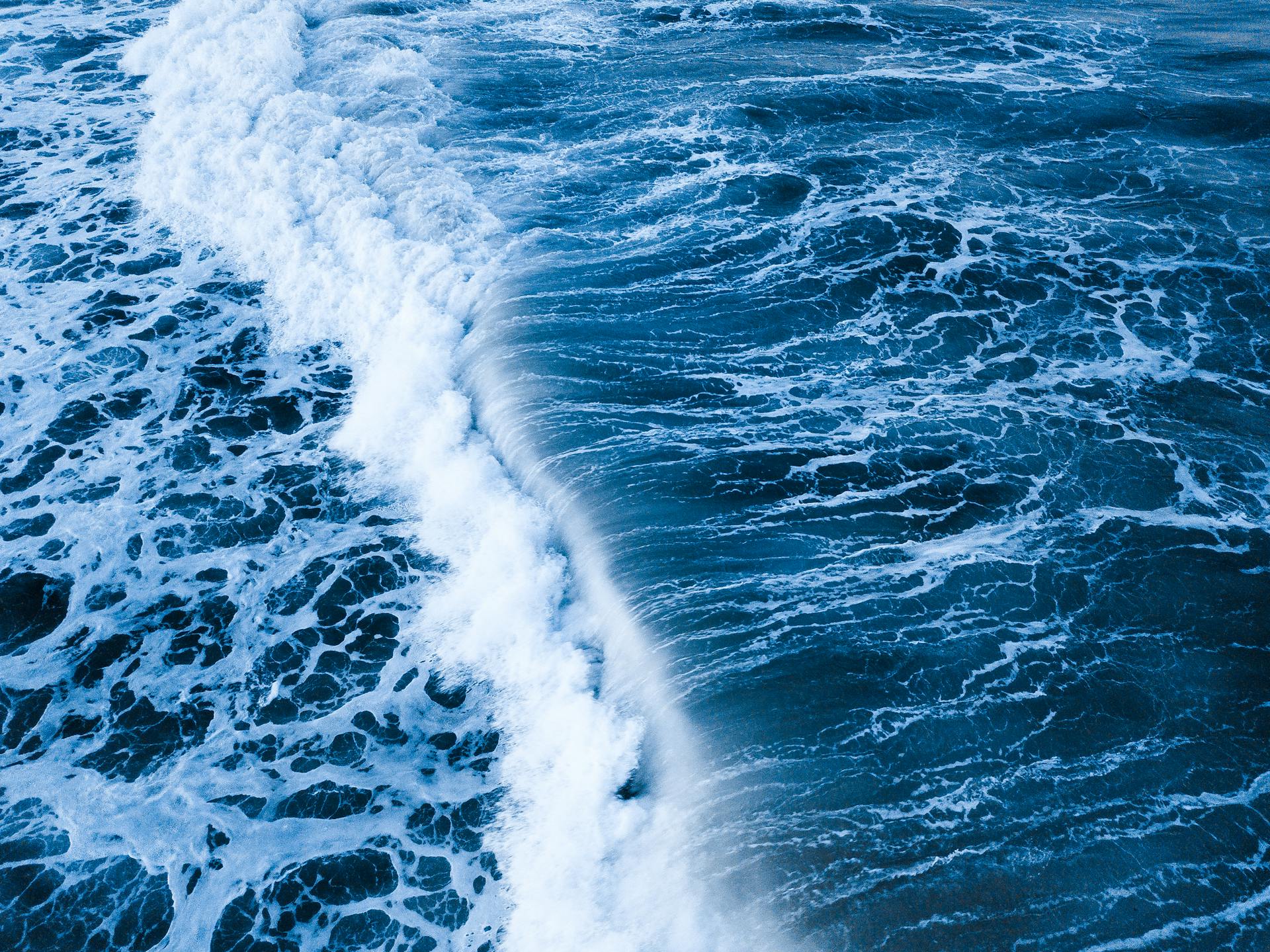
Shore power connection for ships is a game-changer for the maritime industry. By allowing ships to plug into shore-based power, we can significantly reduce greenhouse gas emissions and air pollution.
The International Maritime Organization (IMO) estimates that shore power can reduce emissions by up to 90% during berthing. This is a significant step towards a greener maritime future.
Shore power connections can be implemented at ports and terminals, making it a feasible solution for ships to reduce their environmental impact.
What Is Shore Power?
Shore power refers to the possibility for a ship to plug in to an onshore electricity grid when in port.
This reduces the need for auxiliary engines to generate power, which decreases emissions and noise.
Other terms for shore power include Alternative Marine Power (AMP), Onshore Power Supply (OPS), cold ironing, shore connection, and shore power connection.
These terms are typically used for IEC-80005 standardized plug solutions, which ensure that the vessel will be able to get shore power in any commercial port.
The IEC-80005 standardized plug solutions are used in the High Voltage version, as specified in the IEEE SA - IEEE/IEC 80005-1-2019 standard.
Benefits and Advantages
A shore power connection offers numerous benefits and advantages for ships. One of the most significant advantages is the reduction of emissions, with shore power allowing for the use of renewable power and reducing greenhouse gas emissions.
Using shore power can also save you money on fuel costs, as it can be used to charge your vessel's batteries. This is especially useful for ships that spend extended periods in port.
There are also many regulatory and technical advantages to shore power. Regulations are making shore power more widely available, and standards are already in place for ship-to-shore power connections. This makes it easier to implement shore power on your ship.
Here are some of the key benefits of shore power:
- Shore power can be green power
- Shore power can be used to charge your vessel's batteries
- Regulations are making shore power more widely available
- Standards are already in place for ship to shore power
- Expert systems integrators can help
What Are the Benefits?
There are many benefits to investing in shore power. It's a game-changer for reducing fuel consumption and emissions.
Shore power can be a green power source, reducing our reliance on traditional fuels and minimizing our carbon footprint. This is especially important for the environment.

Regulations are making shore power more widely available, so it's becoming a more practical option for many people. This is a great development.
Standards are already in place for ship-to-shore power connections, making it easier to implement and use. This level of infrastructure is essential for widespread adoption.
Shore power can be used to charge your vessel's batteries, providing a reliable source of energy. This is a great feature for those who need to keep their batteries topped up.
Expert systems integrators can help you set up and integrate shore power into your system, making the process smoother and more efficient.
Green
Shore power is an incredibly green option. In many European countries, up to 50% of electricity is generated from renewable sources like wind, hydro or solar power.
This makes shore power an attractive choice for those looking to reduce their carbon footprint. Connecting to shore power also reduces wear and tear on auxiliary engines.

Using renewable power via a shore connection is a great way to reduce your emissions. You can reduce fuel consumption and emissions by as much as 10% depending on the vessel type and trade.
The potential impact of consistent usage of green shore power can be huge. It's a simple yet effective way to make a positive change.
Infrastructure and Availability
Shore power is becoming more widely available, with hundreds of projects underway on both US coasts, throughout Europe, and at large Asian port hubs.
Regulators are taking action, making it mandatory for ports to install shore power facilities, and co-funding projects as part of their decarbonisation efforts.
From 2030, all container and passenger ships will be required to connect to shore power when they are in a Trans-European Network port for more than two hours, making a shore power connection essential on board.
Shore Power Becoming More Widely Available
Shore power is becoming more widely available, and that's great news for vessel owners. Regulations are making it happen, with governments around the world requiring ports to install shore power facilities.
Hundreds of such projects are already underway on both US coasts, throughout Europe, and at large Asian port hubs. This is a game-changer for those who've been holding off on investing in shore power due to a lack of infrastructure.
From 2030, all container and passenger ships will be required to connect to shore power when in a Trans-European Network port for more than two hours. This legislation is likely to become more common worldwide, making shore power a must-have on board.
Shore power connections are already available at many marine terminals and berths, but this new requirement will ensure that more vessels can take advantage of this technology.
Secure Connections
Secure Connections are crucial for pleasure craft and commercial vessels. The shore power connection is the "life line" from the shore to the boat, ensuring technical equipment remains powered when not cruising.
A comprehensive range of stainless steel and polyamide inlets, high-class connectors, and cables are available for a safe and reliable shore power connection. These connections are vital for keeping electrical devices on board powered.

A vital component of the shore power connection is the battery charger, which recharges and maintains the voltage for service, starter, and bow thruster batteries. This ensures the batteries remain in perfect condition throughout the year.
The WhisperPower battery charger or inverter/charger combi provides sufficient current to power various 12, 24, and/or 120/230 V electrical devices on board. This buffering capacity is essential for maintaining power while on board.
Charging and Maintenance
The shore power connection for ships is designed to be efficient and safe, with a maximum power output of 1,500 kVA.
This allows for a stable and reliable supply of electricity to the ship, reducing the risk of power fluctuations and electrical shocks.
The shore power connection also includes a built-in circuit breaker that automatically disconnects power in case of an overload or fault.
This ensures the safety of the crew and the ship's electrical systems.
Rates
The Port of Oakland has specific rates for shore power usage. The usage rate is $267 per hour, plus applicable taxes.

These rates are outlined in the Port Ordinance, which also includes a maintenance rate of $31 per hour, plus applicable taxes.
If you're planning to use shore power at Berths 60-63, keep in mind that the infrastructure is not owned or managed by the Port. You'll need to contact the terminal operator for utility rates.
There's also an initial vessel commissioning charge of $3,600, which is a one-time fee.
Charges Vessel Batteries
Shore power can be used to charge your vessel's batteries, which is especially useful for fully electric ships or hybrid ships with both engines and batteries.
This allows the ship to sail without using its engines, reducing emissions and fuel consumption.
If the electricity is generated from renewable sources, using the onshore power grid for charging means the vessel can achieve fully zero-carbon operations when running on battery power alone.
Using shore power to charge batteries is a game-changer for vessels that want to reduce their environmental impact.
Vessel Commissioning
If you're planning to call the Port of Oakland and want to plug into shore power, you'll need to go through the vessel commissioning process. This involves preparing a unique vessel to successfully plug into the shore power system at Oakland.
The Port of Oakland requires commissioning for vessels that plan to plug into shore power at specific berths, including 24, 25-26, 30-32, 35-37, 55-59, and 68.
The commissioning process must be repeated until the Port places the vessel on the list of approved shore power vessels. This list can be viewed online.
The Port charges $3,600 per commissioning event for each unique vessel.
Maintenance
The Port of Oakland charges a maintenance rate of $31 per hour (plus applicable taxes) for shore power infrastructure it owns. This rate applies to berths where the Port owns the shore power system.
You'll need to contact the terminal operator for utility rates at Berths 60-63, as the Port doesn't own or manage the infrastructure there.
The Port Ordinance outlines the maintenance rate in more detail, so be sure to check that out if you need more information.
Reliability and Efficiency
A reliable shore power connection is crucial for ships, and it all starts with the right equipment. Complete cable sets for shore to boat connection, such as 15 or 25 meter cables with 16 or 32 amps, complete with connectors and plugs, are essential.
Having a thorough setup also means having the right storage for your cables. A cable storage case is a must-have to keep your cables organized and protected.
Thru-hull stainless steel inlets are another vital component. They provide a secure and durable connection for your shore power cables.
Fuel-Efficient Ship
One container vessel can have an hourly electricity demand of 4,000 kWh.
A 10-hour port stay can translate into enough electricity to power 10 average four-person households for a year.
The number of container ships in the world means that the fuel and emissions savings offered by ship to shore power will be a big step forward for maritime decarbonisation.
Ship to shore power can save fuel and cut vessel emissions, making it a crucial aspect of maritime decarbonisation.
The electricity demand of one container vessel is equivalent to powering 10 average four-person households for a year during a 10-hour port stay.
This highlights the potential for significant fuel and emissions savings through the use of ship to shore power.
Main Ingredients for Reliability
To ensure a reliable shore power connection, you need complete cable sets that can connect your boat to the shore safely. These sets should be 15 or 25 meters long and come in 16 or 32 amp options, complete with the necessary connectors and plugs.
Thru-hull stainless steel inlets are a must-have for a reliable connection. They provide a secure and corrosion-resistant entry point for the shore power cable.
You'll also need plugs that fit the inlets, so make sure to get the right size and type. This will ensure a snug and secure fit.
A cable storage case is a great way to keep your shore power cables organized and protected when not in use. This will help prevent tangles and damage to the cables.
An industrial cable reel can also be a useful addition to your shore power setup. It allows you to easily manage and store your cables, keeping them tidy and within reach.
Why Use Shore Power?
Using shore power is a no-brainer, especially when you consider the environmental benefits. Shore power reduces greenhouse gas emissions by up to 97%.
Shore power is also a cost-effective option, as it eliminates the need for fuel consumption while in port. This can save ships a significant amount of money on fuel costs.
Shore power connections can be installed on ships in just a few hours, making it a quick and efficient solution.
Overview and Introduction
Shore power connection for ships is a game-changer for reducing greenhouse gas emissions and protecting the environment.
It's estimated that ships produce around 13% of global greenhouse gas emissions, making them a significant contributor to climate change.
Shore power connection allows ships to plug into the electrical grid while in port, reducing their reliance on polluting diesel engines.
Overview

Ports are gateways of commerce and drivers of the United States economy. They're also places where large concentrations of diesel equipment can converge and emit significant amounts of air pollution.
Many marine vessels use diesel engines while at berth to power auxiliary systems like lighting, air conditioning, refrigeration, and crew berths. This can have a negative impact on human health and the environment.
The U.S. Environmental Protection Agency (EPA) has developed a report to help port operators, state and local governments, and other stakeholders better understand and evaluate shore power as a potential emissions reduction strategy.
Shore power infrastructure has the potential to significantly reduce emissions by enabling vessels to turn off their engines and plug into the local electricity grid to power auxiliary systems while at berth.
Here are some of the key updates included in the 2022 report:
- New shore power systems in the U.S. since 2017
- Updates to the California Air Resources Board (CARB) regulations, including new shore power requirements
- Updated information on vessel readiness and real-world costs
- Practical operational lessons learned from CARB and port operators
The EPA has also updated its Shore Power Emissions Calculator (SPEC) to include new information and features, such as updated vessel emissions factors and power grid emission factors.
About

I'm excited to share with you what this project is all about. This project aims to provide a comprehensive overview and introduction to a specific topic.
The goal of this project is to educate and inform readers about the importance of this topic. It's a crucial aspect of our daily lives that often goes unnoticed.
The project will cover various aspects of this topic, including its history, benefits, and applications. You'll learn about the different types of this topic and how they're used in real-life scenarios.
Research shows that this topic has been around for centuries, with early civilizations using it for various purposes. Its evolution over time has led to the development of new technologies and innovations.
The project will also explore the challenges and limitations of this topic, providing a balanced view of its advantages and disadvantages. You'll gain a deeper understanding of the complexities involved and how they impact our lives.
By the end of this project, you'll have a solid foundation in this topic and be able to apply your knowledge in practical ways. It's a valuable skill that will benefit you in many aspects of your life.
Sources
- https://www.wartsila.com/marine/products/ship-electrification-solutions/shore-power
- https://www.wartsila.com/insights/article/ship-to-shore-power-5-exciting-reasons-why-it-s-time-to-invest
- https://www.epa.gov/ports-initiative/shore-power-technology-assessment-us-ports
- https://www.oaklandseaport.com/facilities/shore-power
- https://www.whisperpower.com/power-distribution/shore-power-connection
Featured Images: pexels.com
